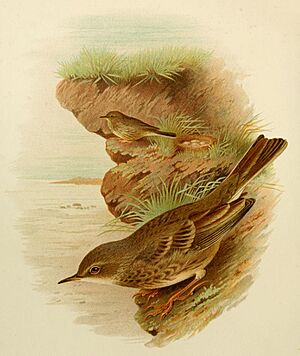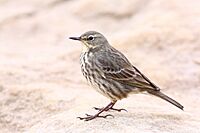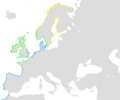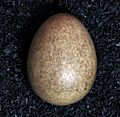European rock pipit facts for kids
Quick facts for kids European rock pipit |
|
|---|---|
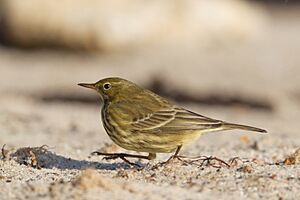 |
|
| On Heligoland in the North Sea | |
| Conservation status | |
| Scientific classification | |
| Genus: |
Anthus
|
| Species: |
petrosus
|
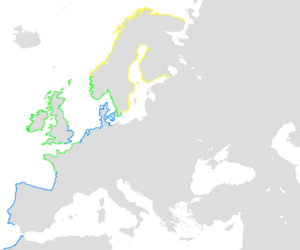 |
|
|
|
| Synonyms | |
|
Anthus spinoletta petrosus (Montagu, 1798) |
|
The European rock pipit (Anthus petrosus) is a small bird found on rocky coasts in western Europe. It has streaky grey-brown feathers on its back and buff-colored feathers underneath. It looks a lot like other pipit birds in Europe.
There are three types, or subspecies, of the European rock pipit. Only the one from Fennoscandia (northern Europe) travels long distances for winter. It flies to warmer coastal areas further south. These birds are very protective of their homes, especially during breeding season. Sometimes, a male rock pipit will even help a neighbor chase away another bird! This is a very rare behavior in the animal kingdom.
European rock pipits build cup-shaped nests under plants or in cracks in cliffs. They lay four to six speckled pale grey eggs. The eggs hatch in about two weeks, and the young birds are ready to fly about 16 days later. Rock pipits mostly eat small bugs and other tiny creatures they find on rocks or in shallow water. They sometimes catch insects in the air too.
Even though rock pipits can be hunted by birds of prey or get parasites like fleas, their population is large and steady. Because of this, experts say they are a "species of least concern." This means they are not currently at risk of disappearing.
Contents
About the Rock Pipit Family
The European rock pipit belongs to a bird family called Motacillidae. This family includes wagtails, pipits, and longclaws. Pipits are the largest group in this family. They are usually brown and eat insects they find on the ground.
Because many pipits look so similar, it can be hard for scientists to tell them apart. For example, the water pipit and the buff-bellied pipit used to be considered the same species as the European rock pipit. But in 1998, they were officially separated. The European rock pipit is closely related to the meadow pipit and red-throated pipit.
Naming the Rock Pipit
The first official description of this bird was by an English naturalist named George Montagu in 1798. He found the bird on the coast of Wales and learned that local fishermen called it the "rock lark." He used this name and gave it the scientific name Alauda petrosus.
The scientific name of the European rock pipit comes from Latin. Anthus is an old Latin name for a small grassland bird. The word petrosus means "rocky," which makes sense for a bird that lives on rocks!
Different Types of Rock Pipits
There are three recognized subspecies of the European rock pipit:
| Image | Subspecies | Where it Lives |
|---|---|---|
 |
Anthus petrosus petrosus | This type breeds in Ireland, Great Britain, northwest France, and the Channel Islands. |
 |
Anthus petrosus kleinschmidti | This type breeds on the Faroe Islands and some Scottish islands like Shetland and Orkney. |
| Anthus petrosus littoralis | This type breeds in Fennoscandia (like Norway and Sweden) and northwestern Russia. It flies south to western Europe and northwest Africa for winter. |
Birds in the western part of the rock pipit's range tend to be darker and have longer beaks. Birds in the east are usually paler with shorter beaks.
What the Rock Pipit Looks Like
The European rock pipit is about 6.5 to 7 inches (16.5 to 17 cm) long. It weighs about 0.6 to 1.1 ounces (18 to 32.5 grams). Its back feathers are a smoky-olive color with faint dark brown streaks. Its belly is buff-colored with blurry brown streaks. Its legs, beak, and eyes are dark brown or black. It also has a light ring around its eye.
Male and female rock pipits look very similar. Young birds look like adults, but they might be a bit browner and more streaky.
Comparing to Other Pipits
The European rock pipit is closely related to the water pipit and the meadow pipit. It looks quite similar to them.
- Compared to the meadow pipit, the rock pipit is darker, bigger, and has longer wings. Its legs are dark, not pinkish-red.
- The water pipit in winter can also look like the rock pipit. But the water pipit has a strong "eyebrow" stripe and greyer upperparts. It is also usually much shyer.
- A key difference is that the European rock pipit has dusky (dark) outer tail feathers, while its relatives have white ones.
Rock Pipit Sounds
The European rock pipit's song is a series of about twenty tinkling "cheepa" notes. These are followed by rising "gee" calls, and then a short trill. Its flight call is a sharp "pseep." This sound is in between the soft "sip sip sip" of the meadow pipit and the short, thin "fist" of the water pipit.
Where Rock Pipits Live
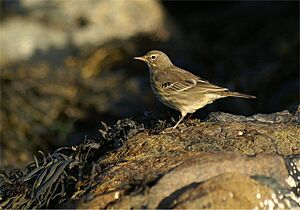
The European rock pipit almost always lives near the coast. It prefers rocky areas, usually below 330 feet (100 meters) in height. It doesn't mind wind or rain, but it avoids very exposed places. In winter or during migration, it might be found further inland.
These birds breed in cool and arctic parts of Europe, along the western and Baltic Sea coasts. A very small number sometimes nest in Iceland. Most rock pipits stay in the same area all year. However, the type that nests on the Faroe Islands and Scottish islands might move to sandy beaches or inland rivers in winter. The type from Fennoscandia mostly migrates. It spends winter on coasts from southern Scandinavia down to southwest Europe. Some even reach Morocco.
Migrating rock pipits leave their breeding grounds in September and October. They return starting in March, though in the far north they might not arrive until May.
Rock Pipit Behavior
The European rock pipit is much easier to get close to than the water pipit. If it gets scared, it flies a short distance close to the ground before landing again. Water pipits are shyer and fly much further away. European rock pipits are usually alone. They only sometimes form small groups.
-
A. p. kleinschmidti on Suðuroy, Faroe Islands
-
Anthus petrosus on Ringstead Bay
-
Anthus petrosus on Swanage
Breeding and Nests
European rock pipits are very protective of their territory during breeding season. Males perform a special song display. They fly 50 to 100 feet (15 to 30 meters) high, then circle or float down to the ground. Sometimes, a male will even go into a neighbor's territory to help chase away an invading bird. This is a very unusual behavior!
Eggs are laid from early April in Britain and Ireland, and later in the north. The nest is always close to the shore. It can be in a crack in a cliff, a hole, or hidden under plants. The female builds the nest using seaweed and dead grass. She lines it with softer fibers or hair.
A female lays four to six eggs. They are shiny pale grey with darker grey or olive speckles, mostly at the wider end. The eggs are incubated for 14 to 16 days. The female does most of the incubating, but males sometimes help. The baby birds are born without feathers and are cared for by the female. They are ready to fly in about 16 days. Both parents might feed the young birds for a few days after they fledge. In warmer areas, they might have two sets of babies in a year. Further north, they usually have only one.
The average lifespan of a European rock pipit is not known, but the oldest recorded one lived for almost 11 years!
What Rock Pipits Eat
European rock pipits mainly eat small creatures without backbones, called invertebrates. They find most of their food by walking around. They only sometimes fly to catch insects. They will even walk into shallow water as waves go out. They might also find food that humans have left behind.
Their diet includes snails, worms, small crustaceans, flies, and beetles. The types of food they eat change with the seasons and where they live. For example, tiny shrimp-like creatures are important food in Ireland and Scotland. In the Netherlands, a type of snail called Assiminea grayana is a favorite. They sometimes eat small fish too. When food is scarce, they might even scavenge for human food scraps.
Rock pipits don't have much competition for food. Other birds that live on rocky beaches, like the purple sandpiper, eat slightly larger food or wade in deeper water. Sometimes, meadow pipits will also feed on the shore. But the European rock pipits will chase them away if there isn't enough food for everyone.
Challenges for Rock Pipits
European rock pipits can be hunted by birds of prey, such as the Eurasian sparrowhawk. They can also be affected by parasites like fleas. The common cuckoo is a "brood parasite." This means the cuckoo lays its eggs in the rock pipit's nest, and the pipit unknowingly raises the cuckoo chick. Cuckoo eggs that are laid in pipit nests often look similar to the pipit's own eggs.
Rock Pipit Population
Experts estimate that there are as many as 408,000 pairs of European rock pipits. About 300,000 of these pairs live in Norway. Even though there have been small drops in the British population, the overall number of rock pipits is large and stable. Because of this, the IUCN says the European rock pipit is a "species of least concern." This means it is not currently threatened.
There are not many major threats to these birds. However, oil spills can temporarily reduce the number of small creatures they eat on rocky coasts.
Images for kids
-
On Heligoland in the North Sea
-
On the rocky beaches of Norwick, Shetland



